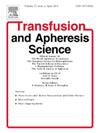肝素在多发性骨髓瘤患者自体干细胞动员中的作用
IF 1.2
4区 医学
Q4 HEMATOLOGY
引用次数: 0
摘要
背景自体造血干细胞移植(aHSCT)已成为符合条件的多发性骨髓瘤(MM)患者的标准治疗方式。影响移植成功的最重要参数之一是收集到的CD34+干细胞的数量。促进CD34+干细胞向外周血释放的最常用药物是粒细胞集落刺激因子和多立沙福。肝素也被证明可以促进CD34+干细胞向外周血的释放。我们的目的是报道肝素对接受aHSCT的MM患者外周血CD34+干细胞数量的影响。材料和方法本多中心回顾性研究分析了138例接受aHSCT诊断为MM的成年患者。患者分为两组:aHSCT前接受肝素治疗的患者(n = 108)和未接受肝素治疗的患者(n = 30)。ResultsThe完全缓解、部分反应,很好的局部响应率的肝素组17 % (n = 18),24 % (n = 26),和59 % (n = 64),分别。non-heparin集团20 %的患者(n = 6)达到完全缓解,而局部反应和很好的部分响应率33 % (n = 10)和47 % (n = 14),分别。在肥胖、ECOG表现评分和吸烟状况方面,组间差异无统计学意义(p = 0.399、0.578和0.602)。肝素组收集到的CD34+干细胞数量和外周血CD34+干细胞峰值计数明显高于对照组(p均为 <; 0.001)。结论肝素可促进CD34+干细胞向外周血的迁移,促进外周血干细胞的收集。本文章由计算机程序翻译,如有差异,请以英文原文为准。
The role of heparin in autologous stem cell mobilization in patients with multiple myeloma
Background
Autologous hematopoietic stem cell transplantation (aHSCT) has become the standard treatment modality for eligible multiple myeloma (MM) patients. One of the most important parameters affecting the success of transplantation is the number of CD34+ stem cells collected. The most commonly used agents to facilitate the release of CD34+ stem cells into peripheral blood are granulocyte colony-stimulating factor and plerixafor. Heparin has also been shown to enhance the release of CD34+ stem cells into peripheral blood. We aimed to report the effect of heparin on the number of CD34+ stem cells in peripheral blood in MM patients who underwent aHSCT.
Materials and methods
This multicenter retrospective study analyzed 138 adult patients diagnosed with MM who underwent aHSCT. Patients were divided into two groups: those who received heparin (n = 108) and those who did not receive heparin before aHSCT (n = 30).
Results
The complete response, partial response, and very good partial response rates in the heparin group were 17 % (n = 18), 24 % (n = 26), and 59 % (n = 64), respectively. In the non-heparin group, 20 % of patients (n = 6) achieved complete response, while partial response and very good partial response rates were 33 % (n = 10) and 47 % (n = 14), respectively. There was no statistically significant difference between the groups regarding obesity, ECOG performance scores, and smoking status (p = 0.399, 0.578, and 0.602, respectively). The number of collected CD34+ stem cells and the peak CD34+ stem cell count in peripheral blood were significantly higher in the heparin group compared to the control group (both p < 0.001).
Conclusion
Heparin has been shown to enhance the migration of CD34+ stem cells into peripheral blood and facilitate the peripheral stem cell collection process.
求助全文
通过发布文献求助,成功后即可免费获取论文全文。
去求助
来源期刊
CiteScore
3.60
自引率
5.30%
发文量
181
审稿时长
42 days
期刊介绍:
Transfusion and Apheresis Science brings comprehensive and up-to-date information to physicians and health care professionals involved in the rapidly changing fields of transfusion medicine, hemostasis and apheresis. The journal presents original articles relating to scientific and clinical studies in the areas of immunohematology, transfusion practice, bleeding and thrombotic disorders and both therapeutic and donor apheresis including hematopoietic stem cells. Topics covered include the collection and processing of blood, compatibility testing and guidelines for the use of blood products, as well as screening for and transmission of blood-borne diseases. All areas of apheresis - therapeutic and collection - are also addressed. We would like to specifically encourage allied health professionals in this area to submit manuscripts that relate to improved patient and donor care, technical aspects and educational issues.
Transfusion and Apheresis Science features a "Theme" section which includes, in each issue, a group of papers designed to review a specific topic of current importance in transfusion and hemostasis for the discussion of topical issues specific to apheresis and focuses on the operators'' viewpoint. Another section is "What''s Happening" which provides informal reporting of activities in the field. In addition, brief case reports and Letters to the Editor, as well as reviews of meetings and events of general interest, and a listing of recent patents make the journal a complete source of information for practitioners of transfusion, hemostasis and apheresis science. Immediate dissemination of important information is ensured by the commitment of Transfusion and Apheresis Science to rapid publication of both symposia and submitted papers.

 求助内容:
求助内容: 应助结果提醒方式:
应助结果提醒方式:


